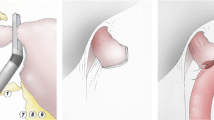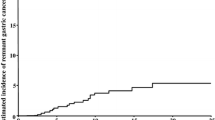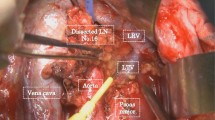Abstract
A European state of the art in the treatment of gastric cancer is presented from the results of a questionnaire. Data were obtained from 62 centers, 60% of which were from abroad and 40% of which were from Germany, reporting a total of 16,594 patients. A feature was a low portion (8.8%) of early cancer. The operation preferred was total gastrectomy. Only in the case of antral carcinoma of the intestinal type, according to Laurén, would the majority perform subtotal gastrectomy. Staging of lymph nodes was performed by 84% of these centers; however, systematic radical dissection was carried out only by 27%. The preferred type of reconstruction after total gastrectomy was Roux-en-Y esophagojejunostomy; 16% of the European centers used some type of pouch in addition. Splenectomy was carried out depending on location of the tumor.
The median in-hospital mortality for early cancer was 0; for carcinoma of the antrum, 6.7%; corpus, 9.6%; and gastroesophageal junction, 11.7%. The median 5-year survival rate in patients with early cancer was 82.5%; for advanced cancer of the antrum, 30.7%; corpus, 24%; and gastroesophageal junction, 15.5%. Ten-year survival was 6–10% less.
It is concluded that in Europe there is a high rate of advanced gastric cancer affecting the results. Improved results may be expected if gastric cancer can be detected earlier and if there is radical lymph node dissection. Generally, prospective randomized studies presented by standardized documentation and statistics are urgently needed.
Résumé
Le point sur la chirurgie du cancer de l'estomac en Europe a été établi à partir des résultats d'un questionnaire unique. Les données sont parvenues de 62 centres différents, 60% d'entre eux étant situés en Allemagne et 40% hors d'Allemagne. Elles concernent 16,954 malades. Un premier point émerge de cette étude: la faible fréquence de cancer précoce (8.8%). L'opération de choix fut la gastrectomie totale. C'est seulement en cas de cancer de l'antre de type intestinal (selon Laurén) que la gastrectomie subtotale fut préférée par la majorité des auteurs. L'examen histologique des ganglions fut pratiqué dans 84% de ces centres et c'est seulement dans 27% des cas que la dissection complète fut réalisée. Dans la majorité des cas la reconstitution du tractus digestif après gastrectomie totale fut réalisée à l'aide d'une oesophago-jéjunostomie avec une anse jéjunale montée en Y à la Roux et c'est seulement dans 16% des cas qu'une poche de type variable fut constituée. L'opération fut complétée parfois par une splénectomie en fonction du siège de la tumeur.
Le taux médian de la mortalité hospitalière fut égal à 0 en cas de cancer précoce et pour les autres stades de 6.7% pour l'antre, de 9.6% pour le corps, et de 11.7% pour la jonction gastro-oesophagienne. Le taux médian de survie à 5 ans fut de 82.5% pour le cancer précoce; pour le cancer avancé il fut de 30.7%; de 24% pour le corps et de 15.5% pour la jonction gastro-oesophagienne. La survie à 10 ans fut de 6–10%.
On peut conclure de ces faits qu'en Europe les résultats observés sont en relation avec la découverte et le traitement tardifs. Ils ne pourront être améliorés que par la découverte du cancer à un stade précoce et par la dissection radicale emportant les ganglions. Il est nécessaire de procéder sans retard à des études randomisées reposant sur une documentation standard et des statistiques irréfutables pour atteindre ce but.
Resumen
Se présenta un “estado del arte” europeo sobre el tratamiento del cáncer gâstrico, basado en los resultados de un cuestionario con preguntas específicas sobre indicaciones para la operación, detalles del acto operatorio, incluyendo “estadificación,” tipo de disección ganglionar, tipo de reconstrucción, el uso de suturadores automáticos, y esplenectomía. Se obtuvieron datos de 62 centros, 40% de los cuales son alemanes y 60% del extranjero, que informaron sobre un total de 16,594 pacientes. Una característica prominente fue la baja proporción del cáncer temprano (8.8%). La operación de preferencia fue la gastrectorrua total. Sólo en casos de carcinoma del antro del tipo intestinal (según Laurén) la mayoría de los cirujanos realizan gastrectomía subtotal. La “estadificación” de los ganglios linfáticos fue realizada en 84% de estos centros. Sin embargo, la disección radical fue realizada sólo en 27%. El tipo preferido de reconstrucción después de gastrectomía total fue la esofagoyeyunostomía de Roux-en-Y; el 16% de los centros europeos informó el uso de algún tipo de bolsa o reservorio adicional. Se realizó esplenectomía según la ubicación del tumor.
La mortalidad hospitalaria para el cáncer temprano fue 0; para carcinoma del antro, 6.7%; del cuerpo, 9.6%; y de la unión gastroesofágica, 11.7%. La tasa de supervivencia a 5 años en pacientes con cancer temprano fue 82.5%; en pacientes con cancer avanzado del antro, 30.7%; del cuerpo, 24%; y de la unión gastroesofágica, 15.5%. La supervivencia a 10 años fue 6–10% menor.
Se llega a la conclusión de que en Europa existe una elevada incidencia de cáncer gástrico avanzado que afecta los resultados. Mejores resultados pueden esperarse con una tasa mayor de cancer temprano y posiblemente con disección ganglionar. Es urgente la necesidad de estudios prospectivos y aleatorizados que se realicen mediante documentación y estadísticas estandarizadas.
Similar content being viewed by others
References
Kodama, Y., Inokuchi, K., Soejima, K., Matsusaka, T., Okamura, T.: Growth patterns and prognosis in early gastric carcinoma. Superficially spreading and penetrating growth types. Cancer51:320, 1983
Sugimachi, K., Kodama, Y., Kumashior, R., Kanemitsu, T., Noda, S., Inokuchi, K.: Critical evaluation of prophylactic splenectomy in total gastrectomy for the stomach. Cancer Gann.71:704, 1980
Priesching, A.: On the problem of “stage-appropriate” treatment of gastric carcinoma. In Gastric Cancer, C. Herfarth, P. Schlag, editors, Berlin-Heidelberg-New York, Springer-Verlag, 1979, pp. 205–214
Baker, R.R.: Argumente gegen die systematische Lymphadenektomie in der Behandlung von Patienten mit Magenkarzinom. In Das Magenkarzinom, H. Rohde, H. Troidl, editors, Stuttgart, Georg Thieme-Verlag, 1984, pp. 165–169
The general rules for the gastric cancer study in surgery and pathology. Jpn. J. Surg.11:127, 1981
Laurén, P.: The two histologic main types of gastric carcinoma: Diffuse and so-called intestinal type carcinoma. Acta Path. Microbiol. Scand.64:31, 1965
TNM-Klassifikation der malignen Tumoren, 3, Auflage, Berlin-Heidelberg-New York, Springer-Verlag, 1979
Geser, K., Junginger, T., Pichlmaier, H.: Behandlungsergebnisse beim Magenfrühkarzinora. Therapiewoche3P:1880, 1980
Maruyama, K.: Results of surgery correlated with staging. In Cancer of the Stomach, P.E. Preece, A. Cuschieri, J.M. Wellwood, editors, London, Grune & Stratton, 1986, p. 145
Hirayama, T.: Methods and results (cost-effectiveness) of gastric cancer screening. In Gastric Cancer: Advances in the Biosciences, vol. 32, J. Fielding, C. Newman, C. Ford, B. Jones, editors, Oxford, Pergamon, 1981, p. 77
Kalish, R.J., Clancy, P.E., Orringer, M.B., Appelman, H.D.: Clinical, epidemiologic, and morphologic comparison between adenocarcinomas arising in Barrett's esophageal mucosa and in the gastric cardia. Gastroenterology86:461, 1984
Ottenjann, R.: Relative Zunahme des Cardiakarzinoms? Dtsch. Med. Wochenschr.109:1303, 1984
Huguier, M., Lancret, J.M., Bernard, P.F., Baschet, C., Le Henand, F.: Functional results of different reconstructive procedures after total gastrectomy. Br. J. Surg.63:704, 1976
Schreiber, H.W., Eichfuss, H.-P., Schumpelick, V.: Magenersatz. Chirurg49:72, 1978
Peiper, H.J., Siewert, R.: Magenersatz. Chirurg49:81, 1978
Seufert, R.M., Wenisch, H.J.C.: Bedeutung der Milzerhaltung beim Magenkarzinom. In Aktuelle Therapie des Magenkarzinoms, H. Bünte, P. Langhans, H.-J. Meyer, R. Pichlmayr, editors, Berlin-Heidelberg-New York-Tokyo, Springer-Verlag, 1985, pp. 113–117
Hölscher, A.H., Siewert, J.R.: Surgical treatment of adenocarcinoma of the gastroesophageal junction. Results of a European Questionnaire (GEEMO). Dig. Surg.2:1, 1985
Kajitani, T., Takagi, K.: Cancer of the stomach at the Cancer Institute Hospital, Tokyo. Gann Monograph on Cancer Research22:77, 1979
Miwa, K.: Cancer of the stomach in Japan. Gann Monograph on Cancer Research22:61, 1979
Soga, J., Kobayaski, K., Saito, J., Fujimaki, M., Muto, T.: The role of lymphadenectomy in curative surgery for gastric cancer. World J. Surg.3:701, 1979
Kodama, Y., Sugimachi, K., Soejima, K., Matsusaka, T., Inokuchi, K.: Evaluation of extensive lymph node dissection for carcinoma of the stomach. World J. Surg.5:241, 1981
Sakita, T.: A nation-wide survey of early gastric cancer in Japan. Gastroenterol. Endoscopy25:317, 1983
Borrmann, R.: Geschwülste des Magens und Duodenums. In Handbuch der speziellen pathologischen Anatomie und Histologie, Band IV, ch. C, part 5, F. Henke, O. Lubarsch, editors, Berlin, Springer-Verlag, 1926
Ming, S.C.: Gastric carcinoma. A pathological classification. Cancer39:2475, 1977
Author information
Authors and Affiliations
Rights and permissions
About this article
Cite this article
Heberer, G., Teichmann, R.K., Krämling, H.J. et al. Results of gastric resection for carcinoma of the stomach: The European experience. World J. Surg. 12, 374–380 (1988). https://doi.org/10.1007/BF01655678
Issue Date:
DOI: https://doi.org/10.1007/BF01655678




